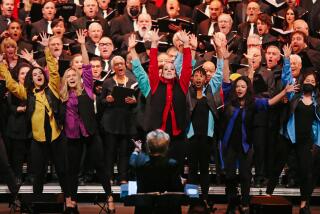Musica Angelica Program Essays Early Vocal Music
- Share via
Some music demands to be performed perfectly, or not at all. The angelic vocal music of the late Renaissance and early Baroque, polyphonic in structure, pure in sound, is a good example.
Musica Angelica--an ensemble that offered a program of the vocal music of Dowland, Purcell, Monteverdi and Gesualdo at Westwood United Methodist Church Friday evening--didn’t quite reach the requisite celestial heights, however, and its concert became a kind of listener’s purgatory.
This was very much attributable to the imperfect quality of the singing. Though director and lutenist Michael Eagan has brought together nine talented singers for the group, they do not yet present a coalesced sound, the precision of ensemble and poignancy of communication necessary to make this music bloom. Mostly, they just got along, solidly but a bit inelegantly.
*
The fact that Musica Angelica’s countertenor was ill certainly couldn’t have helped matters, as Eagan juggled his singers variously to cover the demanding gap.
Musical highlights there were, however, including John Dowland’s chattery “Can she excuse,” with its exuberant confusion of words; Antonio Lotti’s “Crucifixis,” with its chains of suspensions like an audible crown of thorns; and Monteverdi’s “Come dolce hoggi l’auretta,” the sole surviving fragment from his opera “Proserpina rapita,” gracefully warbled by Samela Aird Beasom, Susan Judy and Christen Herman.
Eagan inserted some of his own early-music inspired compositions into the program as well. These ranged from the bright harmonies and slippery chromatics of “To my dear and loving husband,” for three sopranos and lute, to the atonal “Love’s Farewell,” for countertenor, tenor and baritone: brief, well crafted and strikingly textured works.
More to Read
The biggest entertainment stories
Get our big stories about Hollywood, film, television, music, arts, culture and more right in your inbox as soon as they publish.
You may occasionally receive promotional content from the Los Angeles Times.










